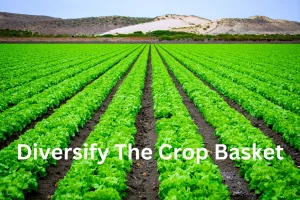ForumIAS announcing GS Foundation Program for UPSC CSE 2025-26 from 19 April. Click Here for more information.
Source-This post on Diversify the crop basket has been created based on the article “Why it is necessary to diversify the farming basket” published in “The Indian Express” on 18 March 2024.
UPSC Syllabus – GS Paper 3 – Agriculture – Issues related to Direct and Indirect Farm Subsidies and Minimum Support Prices.
Context – The article highlights the lessons that can be learnt by Punjab from other states to improve its productivity. Diversify the crop basket
Which states are the most productive states in terms of value creation in agriculture on a per hectare (ha) basis?
There are two ways to estimate the productivity-
1) Divide state Agri-GDP by Net Sown Area (NSA)– In this, Andhra Pradesh (AP) has the highest productivity, followed closely by West Bengal (WB). Punjab ranks 13th.
2) Divide Agri-GDP by Gross Cropped Area (GCA)-In this, Bihar has the highest productivity followed by Odisha.
What are the reasons behind the poor performance of Punjab in terms of value creation in agriculture?
1) Faulty MSP regime-Punjab is over-dependent on rice-wheat system induced by the MSP regime and open-ended procurement. Therefore, Punjab could not diversify production baskets geared towards high-value products.
2) Subsidies – The government gives free power and highly subsidized fertilizers to farmers. These subsidies encourage adoption of the rice-wheat system. For ex- 84% of Punjab’s Gross cropped Area is under wheat and rice, leading to 76 per cent of its blocks being over-exploited in terms of groundwater.
What are the steps that can be taken by Punjab to address this issue?
1) Shift to other crops – A minimum of 1.5 million hectares (Mha) of rice area (out of about 4.5 Mha) needs to be shifted to pulses, oilseeds, maize and fruits and vegetables.
2) Crop-neutral incentive structures – There is a need for institutionalizing crop-neutral incentive structures. Farmers switching to these alternative crops must be rewarded with about Rs 25,000/ha.
Read more- MSP Guarantee Law and Farmer’s Protest
What are the lessons that Punjab can learn from other high performing states?
1) Andhra Pradesh – With 24 % of its agriculture value added (AGVA) attributed to fisheries, AP leads the nation in fish production. It is this proficiency in cultivating high-value shrimp that boosts their profitability. Punjab can also adopt this method.
2) Tamil Nadu – It employs Ultra High-Density Plantation (UHDP) for mango cultivation. This method allows 674 mango trees per acre compared to the traditional method of 40 only. This leads to a significant increase in yield and profits.
3) West Bengal – This is a state with only 2 % agriculture power consumption in 2021-22 creating 40% more value than Punjab. It cultivates vegetables on 15 % (1.5 Mha) of its total GCA. The state has a dedicated Agri-Export Zone (AEZ) for vegetables.
Punjab and Haryana need to embrace a demand-driven high-value agricultural system, if they truly want their farmers to be prosperous. This would require shedding the mindset of an MSP-based cropping system.
Question for practice
Highlight the reasons behind the poor performance of Punjab in terms of value creation in agriculture? What steps can be taken to improve the productivity of agriculture in Punjab?





